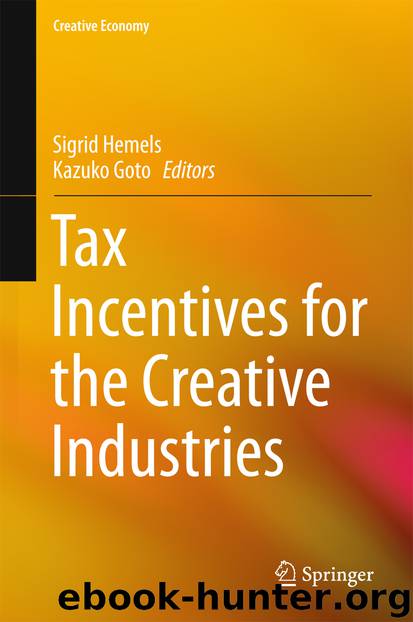Tax Incentives for the Creative Industries by Sigrid Hemels & Kazuko Goto

Author:Sigrid Hemels & Kazuko Goto
Language: eng
Format: epub
Publisher: Springer Singapore, Singapore
2.3.2 Special Rules for Gifts in Kind
Australia and the UK apply special tax incentives for cultural gifts in kind . Donors and institutions must meet many additional requirements to make use of these tax incentives and strict rules apply for valuations .
Australia: Cultural Gifts Program
Since 1978, Australia has applied a Cultural Gifts Program to encourage Australians to donate items of cultural significance from private collections to public art galleries , museums, libraries and archives .22 Since its start, over 680 million Australian dollars’ worth of items have been donated through this program.23 Gifts can range from paintings, books , sculptures , manuscripts and personal papers to jewelry , ceramics and entire technological, mechanical, scientific or social history collections. The receiving institution must determine that the gift confirms with its collection policy and must formally accept the gift into its permanent collection .
The market value of the gift is fully deductible for the donor. Some exceptions apply, for example if conditions are attached to the gift that prevent full custody, control and clear title of the receiving institution, if the donor receives any advantage of material nature or if the item was acquired for the purpose of making the donation (Attorney-General’s Department 2013, p. 19). If an artist or dealer makes a gift that is part of their trading stock, the deduction is restricted to the cost of acquiring or producing the item(s). If it comes from the personal collection of an artist or art dealer , the donor must demonstrate that the item(s) were not held for commercial gain and must have been held in the personal collection for at least 12 months. The deduction can be spread over up to five income years. Furthermore, these gifts are exempt from capital gains tax.
The donor must obtain two valuations of the market value of the gift. The average of these valuations can be deducted. These valuations must be carried out by appraisers who are approved for the program.24 Furthermore, the Attorney-General’s Department (2013), pp. 31–67 gives detailed guidance to the appraisers on how to value the item(s). The donor can claim a tax deduction for the costs of these valuations if these are not paid for by the receiving institution. The receiving institution will arrange the valuations or assist the donor in finding these appraisers. The Ministry of Arts reviews the valuations. Both the donor and the receiving institution must file several forms, meet several requirements and have several obligations for the tax incentive to apply (Attorney-General’s Department 2013).25 Recipient institutions must acknowledge the Cultural Gifts Program when referring to donated works in display labels, publications and, where appropriate, promotional materials to help in promoting and ensuring ongoing support for the program (Attorney-General’s Department 2013, p. 17). The donor must choose one of the acknowledgments included by the Attorney-General’s Department (2013), p. 17. The standard acknowledgement is ‘Donated through the Australian Government’s Cultural Gifts Program ’, but the donor may opt to add their name and/or the name of the person in whose memory the gift was donated.
Download
This site does not store any files on its server. We only index and link to content provided by other sites. Please contact the content providers to delete copyright contents if any and email us, we'll remove relevant links or contents immediately.
Zero to IPO: Over $1 Trillion of Actionable Advice from the World's Most Successful Entrepreneurs by Frederic Kerrest(4077)
Machine Learning at Scale with H2O by Gregory Keys | David Whiting(3666)
Harry Potter and the Goblet Of Fire by J.K. Rowling(3619)
Never by Ken Follett(3550)
Ogilvy on Advertising by David Ogilvy(3354)
Shadow of Night by Deborah Harkness(3184)
The Man Who Died Twice by Richard Osman(2824)
Book of Life by Deborah Harkness(2727)
My Brilliant Friend by Elena Ferrante(2707)
How Proust Can Change Your Life by Alain De Botton(2621)
0041152001443424520 .pdf by Unknown(2613)
Will by Will Smith(2595)
The Tipping Point by Malcolm Gladwell(2566)
How to Pay Zero Taxes, 2018 by Jeff A. Schnepper(2508)
Purple Hibiscus by Chimamanda Ngozi Adichie(2505)
Hooked: A Dark, Contemporary Romance (Never After Series) by Emily McIntire(2428)
Rationality by Steven Pinker(2159)
Borders by unknow(2122)
Daughter of Smoke and Bone by Laini Taylor(2086)
